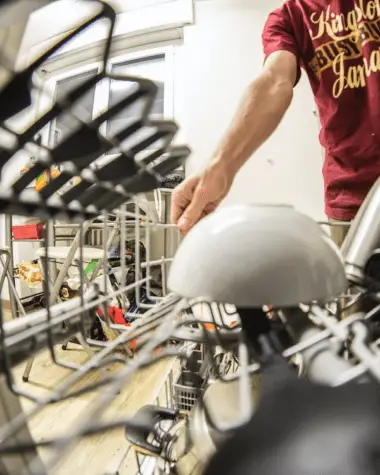Nowadays, dishwashers are arguably as prevalent in modern kitchens as microwaves, stoves, and even refrigerators.
This generation grew up having a trusty machine wherein they could comfortably load up a day’s worth of used dishes and utensils instead of standing upright in front of the kitchen for long periods manually washing them.
So, have you ever wondered how dishwashers came to be?
Who was the brilliant mind behind this machine that made our lives significantly better?
What are the innovations of dishwashers that made them a crucial part of any modern kitchen today?
Let us try and answer all that below.
Here is the history and innovations of dishwashers you probably never heard of.
History of Dishwashers
The first mechanical dishwashing device was registered for a patent more than 170 years ago in the United States by a man named Joel Houghton. His dishwashing device was made of wood and was manually cranked while a stream of water sprayed onto the dishes inside it.
While truly innovative back then, Houghton’s device was both slow and ultimately unreliable.
In 1865, another patent was granted to L.A. Alexander. His device aimed to improve what Houghton’s managed to do by adding a hand-cranked rack system. Sadly, Alexander’s device did not go too well with the public as well.
Neither device was deemed practical – people found them as nothing more but a novelty device instead of a helpful device that would make their lives easier.
The most successful of the hand-powered dishwashers was invented by a wealthy woman named Josephine Cochrane in 1886. She worked with George Butters, a mechanic, to create a device that could thoroughly wash her valuable porcelain without breaking or damaging them the slightest.
In reality, Cochrane’s motivation in creating the device came from her frustration at the damage to her valuable items when her servants handled them during cleaning. The two worked in Cochrane’s tool shed in Shelbyville, Illinois.
Their invention was later unveiled at the 1893 World’s Fair in Chicago under the name of ‘Lavadora’ but was later changed to ‘Lavaplatos’ as another device with the name Lavadora was already registered in 1858.
Unlike the first two devices patented by Houghton and Alexander, Cochrane’s was received much better, and to this day, she is widely considered the true inventor of the modern dishwashers we so love today.
Sixty-six years later, William Howard Livens of the United Kingdom invented a small, non-electric dishwasher suitable for domestic use. It was the first dishwashing device that incorporated most of the design elements that are featured even in today’s newest models.
The English man’s device included a door for loading, a wire rack to hold the dirty dishes and utensils, and a rotating water sprayer. In 1940, drying elements were added to his design.
It was the first dishwasher deemed suitable for domestic use, and it came at a time when permanent plumbing and running water in the home were becoming more common.
Livens arguably contributed the most to the evolution of the dishwashers we are now so familiar with today. That being said, it is also worth pointing out that his design ultimately failed commercially.
His dishwashers were only successfully sold as domestic utilities in the postwar boom of the 1950s. And as you would expect, only wealthy people could enjoy his device’s conveniences.
At first, dishwashers were sold as portable or standalone devices, but with the development of the wall-to-wall countertop and standardized height cabinets, these dishwashers began to be marketed with standardized shapes and sizes, integrated underneath the kitchen countertop as modular units with other convenient kitchen appliances.
In the early 1970s, dishwashers had already become common in domestic residences in both Western Europe and North America. And by 2012, 3 of 4 homes in the United States and Germany already had dishwashers at their disposal.
Now that we are reminded of the past and the birth of dishwashers, let us now look forward and see the innovations in the machine within the past few years that you have probably never heard of…until now.
Dishwasher Innovations You Probably Never Heard Of
Without looking at dishwashers close up, you’d likely miss the innovations that’ve been happening within them. That is because it is all hidden inside the machines, impossible to be discerned with just one glance – especially to non-professional consumers.
Furthermore, even though dishwashers are ultra-convenient and make life that much easier, they are arguably the least exciting type of kitchen appliance you can get. There are no heart-racing open flames like a grill or over, and it does not store essentials or your favorite drinks like a fridge.
With that in mind, it’s understandable that dish-cleaning innovations don’t get that much highlight as compared to other kitchen appliance innovations. However, it does not mean that they aren’t noteworthy.
In fact, some of these innovations are more impressive than the ones we have grown tired of hearing from other appliances. Without further ado, here are some of the lesser-known innovations that have been happening in the world of dishwashers.
Non-Handle Dishwasher Designs
Miele recently unveiled their design for a non-handle dishwasher. Instead of the conventional pulling of the handle, Miele’s handleless dishwasher requires a simple knock on its front panel to open its door. As impressive as this may sound on paper, there is still no clear indication of whether or not the design is destined to hit US retailers.
In Europe, it just makes sense, seeing as their kitchens tend to be snugly designed with appliances that are often flush with the cabinetry. A dishwasher with no handle just works well with that kind of kitchen setting.
6th Sense Live Technology
Whirlpool’s 6th Sense Live technology makes it possible to connect your dishwasher to your local WiFi network to bring you the many benefits of a smart grid system – eliminating the need for a smart electric meter.
While significantly more expensive than conventional dishwashers, 6th Sense dishwashers determine when electricity consumption will be the least expensive, thus, helping you save more money in the long run. The dishwasher can run whenever grid consumption is cheapest with just a single button press. This makes such dishwashers perfect for anyone who wishes to have a smart home.
OrbitClean System
Frigidaire’s OrbitClean system includes an independent, rotating spray arm inside the dishwasher, ensuring that the dirty dishes and utensils you feed the machine come out squeaky clean and remove from any germs as much as possible.
According to Frigidaire, the circular device delivers over four times better water coverage than its contemporaries in the dishwashing industry.
AquaSense Recycling System
As people become more and more environmentally conscious, innovations will tend to focus more on efficiency and eco-friendly options while still ensuring that they can optimally clean our dishes.
One example of this is KitchenAid’s AquaSense Recycling System which smartly uses leftover water from prior rinse cycles to pre-rinse the next batch of dirty dishes. At first, it may sound unsanitary but worry not; it uses fresh water to complete the cleaning process.
As per KitchenAid, dishwashers with the AquaSense system use 33% less water compared to conventional dishwashers.
Related Article: The Environmental Effects of Using a Dishwasher (12 Facts & Statistics)
Bottle Wash Jets
While dishwashers are mostly known for cleaning dishes, hence the name, they are also convenient for keeping our glasses and bottles germ-free.
Recently, GE unveiled a new batch of dishwashers that incorporates a unique bottle-washing component. It has jets on the upper racks designed to fit tall containers with small openings. This includes baby bottles and sports bottles.
The company claims this feature as an industry-first. As trivial as bottle wash jets may sound on paper, it is definitely a noteworthy innovation that continues to prove dishwashers as the ultimate kitchen cleaner appliance.
Zeolite Crystals
The inclusion of Zeolite is arguably the most amazing innovation that has happened to the dishwashing world for quite some time. Bosch’s Zeolite technology uses Zeolite crystal to heat the interior of the dishwasher during the dry cycle – without consuming any electricity in the process.
It does this by absorbing the water from the previous wash cycle, whereupon the microporous mineral heats up to insanely high temperatures, thus, drying the dishes inside in just a matter of minutes, if not shorter. Saying that this innovation is impressive feels like a major understatement.
Conclusion
To better appreciate today’s innovations is to recognize the past. With the help of this article, you are made aware of the conception of the dishwasher and how it was molded over the years to become what it is now. On top of that, you have also learned about the recent innovations in the dishwashing world that are sure to become more impressive as time goes by.
With all that being said, you may also want to look at our top picks for the best dishwashers this 2023.









